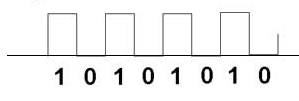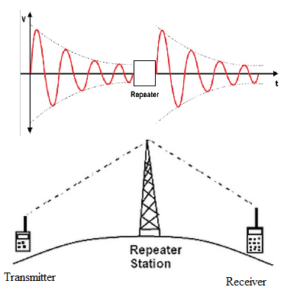Science > Physics > Communication > Terminology of Communication System
In this article, we are going to study the terms used in the communication system and the concept of the bandwidth of a signal.
Transducer:
Any device that converts one form of energy into another can be termed as a transducer.
Example: A microphone is a transducer which converts sound energy into electrical energy (electrical signals). A loudspeaker is a transducer which converts electrical energy (electrical signals) into sound energy.
An electrical
transducer may be defined as a device that converts some physical variable
(pressure, displacement, force, temperature,
etc) into corresponding variations in the electrical
signal at its output.
Signal:
Information converted into electrical form and suitable for transmission is called a signal. Signals can be either analog or digital. A message is defined as a physical manifestation of information as produced by the source. The terms signal and message are used interchangeably.
In an electronic communication system, a signal means a time-varying electrical signal obtained from the original signal using a transducer. These signals have their own nature, frequency, and amplitude. There are two types of electrical signals
Analog Signals:
An analog signals are continuous variations of voltage or current. They are essentially single-valued functions of time. The sine wave is a fundamental analog signal. All other analog signals can be fully understood in terms of their sine wave components. Sound and picture signals in TV are analog in nature.

The general equation of such signal is Q = Qo sin ωt here ω = 2π/T
Digital Signals:
Digital signals are those which can take only discrete stepwise values. A binary system that is extensively used in digital electronics employs just two levels of a signal. ‘0’ corresponds to a low level and ‘1’ corresponds to a high level of voltage/ current. Generally, such signals are in the form of pulses. There are several coding schemes used for digital communication. The output of a computer, transmission of documents through the internet is done using digital signals. The digits 0 and 1 are called bits. A group of bits is called a byte or binary word. There are several coding schemes used for digital communication. They employ suitable combinations of number systems such as the binary coded decimal (BCD). American Standard Code for Information Interchange (ASCII) is a universally popular digital code to represent numbers, letters, and certain characters.

Noise:
Noise refers to the unwanted signals that tend to disturb the transmission and processing of message signals in a communication system. The source generating the noise may be located inside or outside the system. Lightning, turning on or off electrical appliances may cause noise.
Transmitter:
A transmitter processes the incoming message signal so as to make it suitable for transmission through a channel and subsequent reception. The important component of a transmitter in radio communication are microphone, audio amplifiers, oscillator, modulator, and antenna.
Receiver:
A receiver extracts the desired message signals from the received signals at the channel output. The important components of a receiver in radio communication are an antenna, demodulator, amplifier, loudspeaker.
Communication Channel:
It is a link connecting a transmitter and a receiver. It is the physical medium which carries the signal from transmitter to the receiver ideally without any noise or distortion. The atmosphere, optical fibres, parallel wires, coaxial cables, etc. are used as communication channels. Communication channels are divided into two types.
- Guided communication channel: This is generally used in point to point or in-line communication. Parallel wires, coaxial cables are used for this type of communication.
- Non-guided communication channel: This channel is used for space and satellite communication. Free space is an example of a non-guided communication channel.
Attenuation:
The loss of strength of a signal while propagating through the communication channel is known as attenuation.
Amplification:
It is the process of increasing the amplitude (and consequently the strength) of a signal using an electronic circuit called the amplifier. Amplification is necessary to compensate for the attenuation of the signal in communication systems. The energy needed for additional signal strength is obtained from a DC power source. Amplification is done at a place between the source and the destination wherever signal strength becomes weaker than the required strength.
Range:
It is the largest distance between a source and a destination up to which the signal is received with sufficient strength.
Repeater:
A repeater is a combination of a receiver and a transmitter. A repeater picks up the signal from the transmitter, amplifies and retransmits it to the receiver sometimes with a change in carrier frequency. Thus repeaters serve as amplifiers. Repeaters are used to extend the range of a communications system keeping original form intact. A communication satellite is essentially a repeater station in space. Mobile towers are the repeaters.

Modulation:
The original low-frequency message/ information signal cannot be transmitted to long distances. Therefore, at the transmitter, the information contained in the low-frequency message signal is superimposed on a high-frequency wave, which acts as a carrier of the information. This process is known as modulation. There are several types of modulation, abbreviated as amplitude modulation (AM), frequency modulation (FM), and phase modulation (PM).
Demodulation:
The process of retrieval of information from the carrier wave at the receiver is termed demodulation. This is the reverse process of modulation. Thus at the end of the process low-frequency message is retrieved again.
Antenna:
An antenna or aerial is a system of elevated conductors which couples the transmitter or receiver to the communication channel. Thus it is required at both ends i.e. transmitter end and receiver end. The same antenna can be used for transmitting and receiving functions.
Bandwidth:
Bandwidth refers to the frequency range over which equipment operates or the portion of the spectrum occupied by the signal.
A Bandwidth of a Signal:
In a communication system, the message signal can be voice, music, and picture or computer data. Each of these signals has different ranges of frequencies. The type of communication system needed for a given signal depends on the band of frequencies which is considered essential for the communication process.
| Signals | Frequency Range | Bandwidth of signal |
| Speech | 300 Hz to 3100 Hz | 2800 Hz |
| Music | 20 Hz to 20000 Hz | 19980 Hz |
| Video | 1500 MHz to 1506 MHz | 6 MHz |
| Computer data | 2000 MHz to 2600 MHz | 600 MHz |
The important thing to be noted that irrespective of where the band is located in the frequency spectrum, it will carry the same amount of information. For example, Signal will carry the same amount of information in a frequency range from 1 MHz to 2 MHz (bandwidth 1 MHz) or the frequency range from 5 MHz to 6 MHz (Bandwidth 1 MHz)
Bandwidth of Transmission Medium:
Similar to message signals, different types of transmission media offer different bandwidths. The commonly used transmission media are wire, free space, and fibre optic cable. Coaxial cable is a widely used wire medium, which offers a bandwidth of approximately 750 MHz. Such cables are normally operated below 18 GHz. Communication through free space using radio waves takes place over a very wide range of frequencies: from a few hundreds of kHz to a few GHz. This range of frequencies is further subdivided and allocated for various services. Optical communication using fibres is performed in the frequency range of 1 THz to 1000 THz (microwaves to ultraviolet). An optical fibre can offer a transmission bandwidth in excess of 100 GHz.
Spectrum allocations are arrived at by an international agreement. The International Telecommunication Union (ITU) administers the present system of frequency allocations.
Frequency allocation to different services is given below.
| Nature of Broadcast | Frequency Band |
| Amplitude modulated (AM) | 540 kHz to 1600 kHz |
| Frequency modulated (FM) | 88 MHz to 108 MHz |
| Very high frequency (VHF) T.V. | 54-72 MHz to 174-216 MHz |
| Ultra high frequency (UHF) T.V. | 420 MHz to 890 MHz |
| Mobile telephony Mobile to base station | 896 MHz to 901 MHz |
| Mobile telephony Base station to Mobile | 840 MHz to 935 MHz |
| Satellite Communication Uplink | 5.925 GHz to 6.425 GHz |
| Satellite Communication Downlink | 3.7 GHz to 4.2 GHz |
Previous Topic: Introduction to Communication System
Next Topic: Communication Channels: Atmosphere
